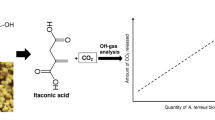Abstract
Armillaria sp. F022, a white-rot fungus isolated from decayed wood in tropical rain forest was used to biodegrade anthracene in cultured medium. The percentage of anthracene removal by Armillaria sp. F022 reached 13 % after 7 days and at the end of the experiment, anthracene removal level was at 87 %. The anthracene removal through sorption and transformation was investigated. 69 % of eliminated anthracene was transformed by Armillaria sp. F022 to form other organic structure, while only 18 % was absorbed in the mycelia. In the kinetic experiment, anthracene dissipation will not stop even though the biomass had stopped growing. Anthracene removal by Armillaria sp. F022 was correlated with protein concentration (whole biomass) in the culture. The production of enzyme was affected by biomass production. Anthracene was transformed to two stable metabolic products. The metabolites were extracted in ethyl-acetate, isolated by column chromatography, and then identified using gas chromatography–mass spectrometry (GC–MS).




Similar content being viewed by others
References
Doyle E, Muckian L, Mickey AM, Clipson N (2008) Microbial PAH degradation. Adv Appl Microbiol 65:27–66
Miller KP, Borgeest C, Greenfield C, Tomic D, Flaws JA (2004) In utero effects of chemicals on reproductive tissues in females. Toxicol Appl Pharmacol 198:111–131
Jacques RJS, Santos EC, Bento FM, Peralba MCR, Selbach PA, Sa′ ELS, Camargo FAO (2005) Anthracene biodegradation by Pseudomonas sp. isolated from a petrochemical sludge landfarming. Int Biodegrad Biodeterior 56:143–156
Cajthaml T, Erbanova P, Sasek V, Moeder M (2006) Breakdown products on metabolic pathway of degradation of benz[a]anthracene by a ligninolytic fungus. Chemosphere 64:560–564
Ramsay JA, Hao L, Brown RS, Ramsay BA (2003) Naphthalene and anthracene mineralization linked to oxygen, nitrate, Fe(II) and sulphate reduction in a mixed microbial population. Biodegradation 14:321–329
Budavari S, O’Neil JM, Smith A, Heckehman EP, Kinneary JF (1996) The Merck index, 12th edn. Merck Research Laboratory Division, Whitehouse Station
Luning Prak DJ, Pritchard PH (2002) Solubilization of polycyclic aromatic hydrocarbon mixtures in micellar nonionic surfactant solution. Water Res 36:3463–3472
Kristanti RA, Hadibarata T, Toyama T, Tanaka Y, Mori K (2011) Bioremediation of crude oil by white rot fungi Polyporus sp. S133. J Microbiol Biotechnol 21:995–1000
Hadibarata T, Yusoff ARM, Aris A, Kristanti RA (2012) Identification of naphthalene metabolism by white rot fungus Armillaria sp. F022. J Environ Sci 24:728–732
Head IM, Jones DM, Roling WFM (2006) Marine microorganisms make a meal of oil. Nat Rev Microbiol 4:173–182
Evans WC, Fernley HN, Griffits E (1965) Oxidative metabolism of phenanthrene and anthracene by soil pseudomonads. Biochem J 98:819–831
Hadibarata T, Khudhair AB, Salim MR (2012) Breakdown products in the metabolic pathway of anthracene degradation by a ligninolytic fungus Polyporus sp. S133. Water Air Soil Pollut 223:2201–2208
Pointing SB (2001) Feasibility of bioremediation by white-rot fungi. Appl Microbiol Biotechnol 57:20–33
Obruca S, Marova I, Matouskova P, Haronikova A, Lichnova A (2012) Production of lignocellulose-degrading enzymes employing Fusarium solani F-552. Folia Microbiol 57:221–227
Hadibarata T, Yusoff ARM, Aris A, Salmiati, Hidayat T, Kristanti RA (2012) Decolorization of Azo, triphenylmethane and anthraquinone dyes by laccase of a newly isolated Armillaria sp. F022. Water Air Soil Pollut 223:1045–1054
Lowry OH, Rosebrough NJ, Farr AL, Randall RJ (1951) Protein measurement with folin phenol reagent. J Biol Chem 193:265–275
Hadibarata T, Tachibana S, Askari M (2011) Identification of metabolites from phenanthrene oxidation by phenoloxidases and dioxygenases of Polyporus sp. S133. J Microbiol Biotechnol 21:299–304
Wu YR, He TT, Lun JS, Maskaoui K, Huang TW, Hu Z (2009) Removal of benzo[a]pyrene by a fungus Aspergillus sp. BAP14. World J Microbiol Biotechnol 25:1395–1401
Yong LY, Cerniglia CE (2005) Microbial transformation and degradation of toxic organic chemicals. Wiley-Liss, New York
Samanta SK, Chakrabarti AK, Jain RK (1999) Degradation of phenanthrene by different bacteria: evidence for novel transformation sequences involving the formation of 1-naphthol. Appl Microbiol Biotechnol 53:98–107
Jim AF, Ronald HV, John GVZ, Wim HR (1996) The tolerance of lignin peroxidase and manganese-dependent peroxidase to miscible solvents and the in vitro oxidation of anthracene in solvent: water mixtures. Enzyme Microb Technol 18:300–308
Fentem JH, Fry JR (1993) Species differences in the metabolism and hepatotoxicity of coumarin. Comp Biochem Physiol 104:1–8
Floc’h F, Mauger F, Desmurs JR, Gard A, Bagneris F, Carlton B (2002) Coumarin in plants and fruits: implications in perfumery. Perfum Flavor 27:32–37
Acknowledgments
A part of this project was financially supported by Universiti Teknologi Malaysia (RUG Vote QJ1.3000.2522.02H65).
Author information
Authors and Affiliations
Corresponding author
Rights and permissions
About this article
Cite this article
Hadibarata, T., Zubir, M.M.F.A., Rubiyatno et al. Microbial transformation and sorption of anthracene in liquid culture. Bioprocess Biosyst Eng 36, 1229–1233 (2013). https://doi.org/10.1007/s00449-012-0850-x
Received:
Accepted:
Published:
Issue Date:
DOI: https://doi.org/10.1007/s00449-012-0850-x




